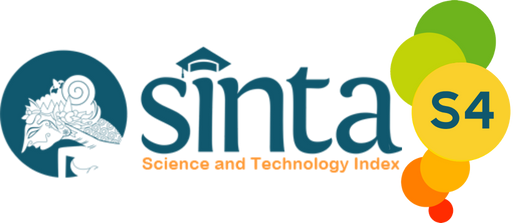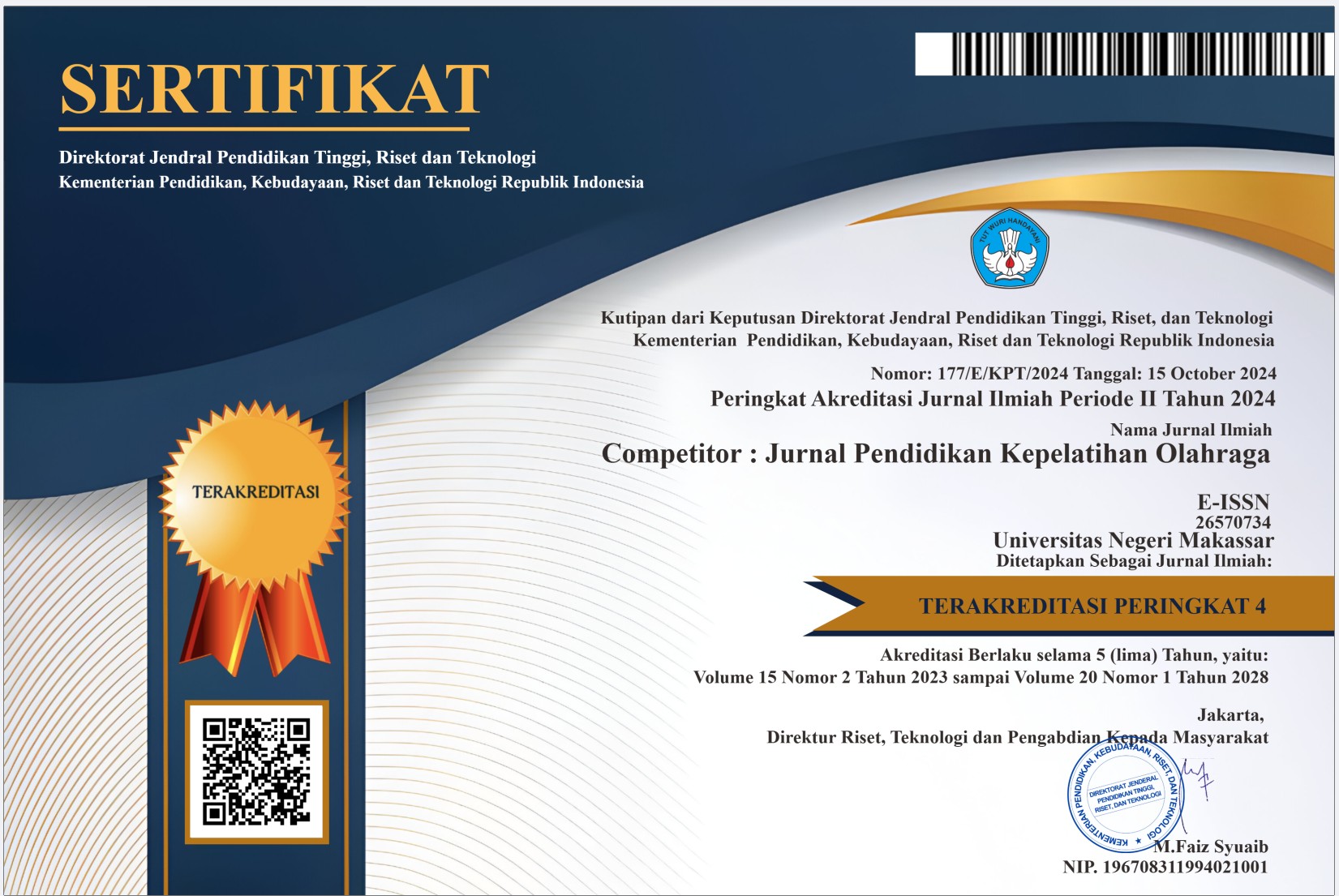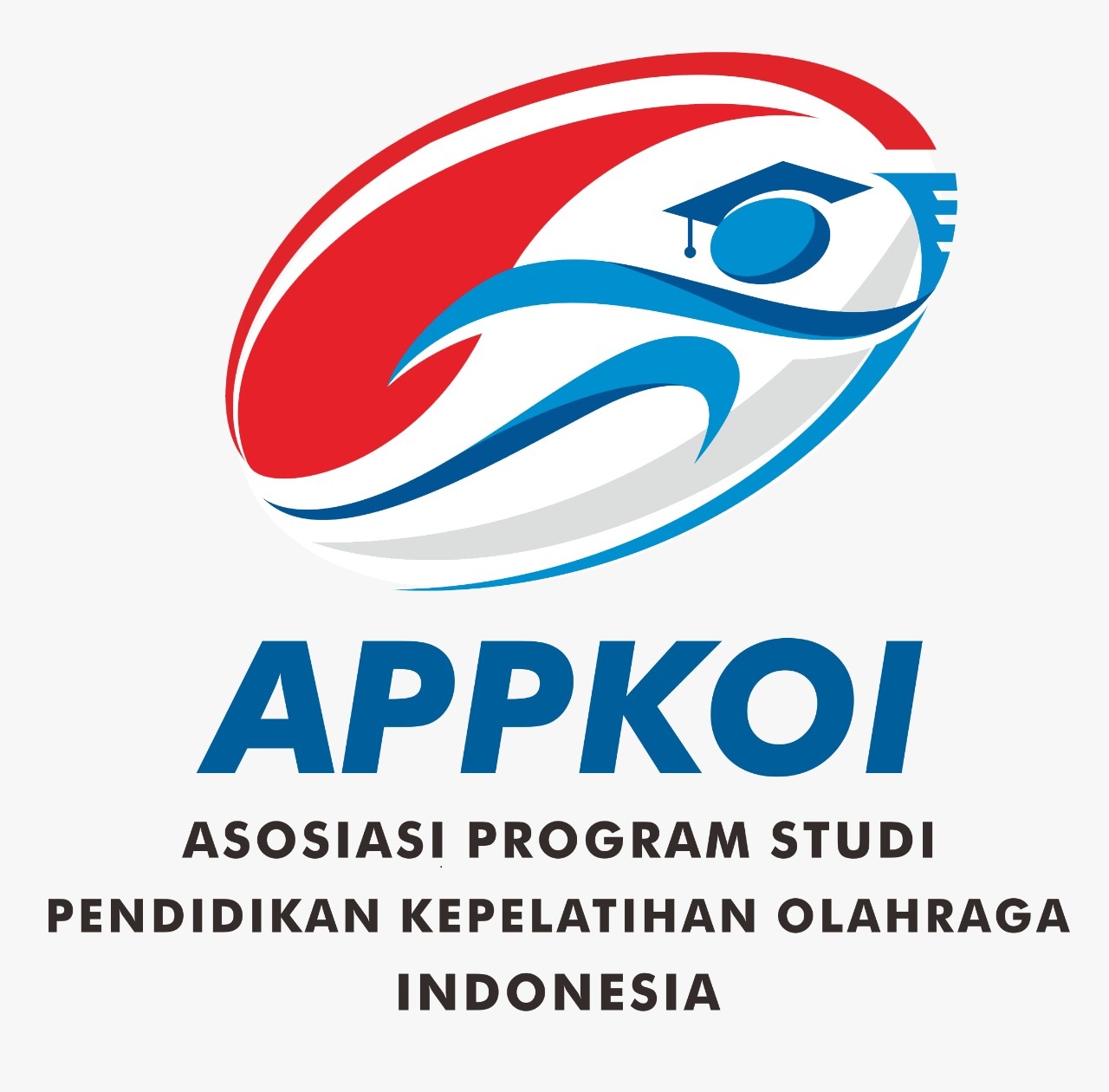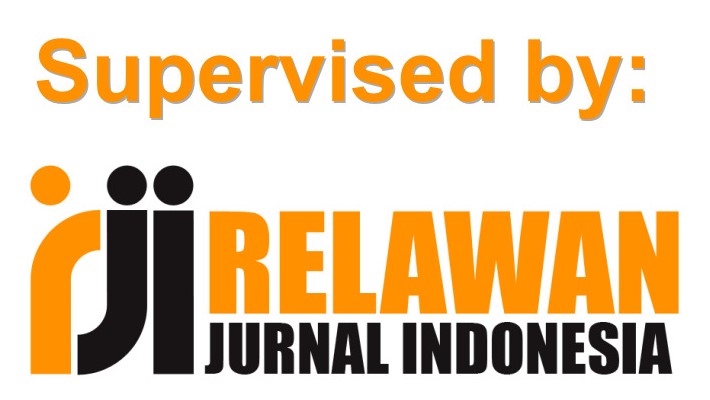The Effect of Walking Lunges and Squat Side Kick Exercises on Mawashi Geri Kick Speed in Inkanas Karate Athletes Aged 13-15 Years, UNM Makassar Branch
DOI:
https://doi.org/10.26858/cjpko.v17i2.71992Keywords:
Exercises Walking Lunges, Squat Side Kick, Mawashi Geri Kick, Karate.Abstract
The purpose of this study was to compare the effectiveness of double-leg hurdle jumps and single-leg hurdle jumps in increasing the shooting speed of soccer players at SMPN 3 Bontomarannu. This study aimed to determine the effect of walking lunges and squat side kick exercises on the speed of mawashi geri kicks in INKANAS karate athletes aged 13-15 years at the UNM Makassar branch. This study is an experimental study. The population of this study was 24 Inkanas karate athletes aged 13-15 years at the UNM Makassar branch. The research sample was 24 Inkanas karate athletes aged 13-15 years at the UNM Makassar branch. The data analysis technique used inferential testing on t-test statistics. The results of the study showed that 1) there was an effect of walking lunges training on the speed of mawashi geri kicks in Inkanas karate athletes aged 13-15 years at the UNM Makassar branch. This can be seen from the results of the analysis obtained a t-value of -8.074 with a probability (sig) = 0.000 smaller than 0.05. 2) there is an effect of squat side kick training on the speed of mawashi geri kicks in Inkanas karate athletes aged 13-15 years at the UNM Makassar branch. This can be seen from the results of the analysis obtained a t-value of -12.318 with a probability (sig) = 0.000 smaller than 0.05. 3) there is an effect of walking lunges and squat side kick training that is better on the speed of mawashi geri kicks in Inkanas karate athletes aged 13-15 years at the UNM Makassar branch. This can be seen from the results of the analysis obtained a t-value of -1.381 with a probability (sig) = 0.040 smaller than 0.05. In addition, seen from the average difference between the two exercise groups where the average value is 25.75 (walking lunges exercise) and 28.50 (squat side kick exercise). Conclusion Squat side kick exercise is better than walking lunges exercise on mawashi geri kick speed in INKANAS karate athletes aged 13-15 years, UNM Makassar branch.
References
Abidin, M. Z. (2019). Pengaruh latihan walking lunges terhadap peningkatan power otot tungkai atlet beladiri. Jurnal Keolahragaan Indonesia, 7(2), 104-112. https://doi.org/10.21831/jki.v7i2.26981
Adam Mappaompo, M., Aprilo, I., Elisano Arfanda, P., & Arga. (2024). Shooting Accuracy Of Sports Coaching Education Students : Goaling Game Practice. Indonesian Journal of Research and Educational Review, 3(3), 204–210. https://doi.org/10.51574/ijrer.v3i3.1995
Arga. (2025). Pengaruh Latihan Leg Raise Terhadap Kekuatan Otot Perut Mahasiswa PKO UPRI. Jurnal Pendidikan Kepelatihan Olahraga (PEJUANG), 1(1), 18–23.
Arga, Arkanul Arba, M., Rahmatullah, W., Nurhalizah Mutia Aulria, S., & Tandi Rerung, C. (2024). Football Dribbling Speed Reviewed From Running Speed. KING : Knowledge Integrated Networking for Global Sport and Health, 1, 64–68. https://jurnal.sainsglobal.com/index.php/king
Beneke, R., Beyer, T., Jachner, C., Erasmus, J., & Hütler, M. (2019). Energetics of karate kumite. European Journal of Applied Physiology, 92(4-5), 518–523. https://doi.org/10.1007/s00421-004-1073-x
Chaabène, H., Franchini, E., Miarka, B., Selmi, M. A., Mkaouer, B., & Chamari, K. (2018). Time-motion analysis, physiological and rate of perceived exertion responses to karate official combats: Is there a difference between winners and defeated karatekas? International Journal of Sports Physiology and Performance, 9(2), 302–308. https://doi.org/10.1123/ijspp.2012-0353
Cynarski, W. J., & Lee-Barron, J. (2018). Philosophies of martial arts and their pedagogical consequences. Ido Movement for Culture. Journal of Martial Arts Anthropology, 14(1), 11-19. https://doi.org/10.14589/ido.14.1.2
Gunawan, J. (2020). Efektivitas metode latihan walking lunges untuk meningkatkan kecepatan tendangan pada atlet karate. Jurnal SPORTIF: Jurnal Penelitian Pembelajaran, 6(2), 272-287. https://doi.org/10.29407/js_unpgri.v6i2.14347
Hadi, S. (2007). Pengaruh latihan beban walking lunges terhadap peningkatan kekuatan tungkai atlet taekwondo. Jurnal Olahraga Prestasi, 3(1), 42-56. https://doi.org/10.21831/jorpres.v3i1.6713
Hairy, J. (2003). Dasar-dasar fisiologi olahraga. Universitas Terbuka Press. https://doi.org/10.31227/osf.io/vm5fp
Herdiyana, A., & Prakoso, G. P. W. (2020). Pembelajaran pendidikan jasmani yang mengacu pada pembiasaan sikap fair play dan kepercayaan pada peserta didik. Jurnal Olahraga, 5(2), 111-126. https://doi.org/10.37742/jo.v5i2.148
Ihsan, N., Sari, I. P. T. P., & Muhammadiah, J. (2023). Analisis kualitatif teknik tendangan mawashi geri pada atlet karate. Altius: Jurnal Ilmu Olahraga dan Kesehatan, 12(1), 56-65. https://doi.org/10.36706/altius.v12i1.20021
Irianto, D. P., & Issomudin, R. (2019). Pengaruh latihan walking lunges terhadap peningkatan keterampilan tendangan pada karateka pemula. Jurnal Pendidikan Jasmani dan Olahraga, 4(1), 68-75. https://doi.org/10.17509/jpjo.v4i1.14465
James, L. P., Haff, G. G., Kelly, V. G., & Beckman, E. M. (2018). Towards a determination of the physiological characteristics distinguishing successful mixed martial arts athletes: A systematic review of combat sports literature. Sports Medicine, 46(10), 1525-1551. https://doi.org/10.1007/s40279-016-0493-1
Koropanovski, N., Berjan, B., Bozic, P. R., Pazin, N., Sanader, A., Jovanovic, S., & Jaric, S. (2020). Anthropometric and physical performance profiles of elite karate kumite and kata competitors. Journal of Human Kinetics, 30(1), 107-114. https://doi.org/10.2478/v10078-011-0078-x
Lloyd, R. S., Oliver, J. L., Faigenbaum, A. D., Myer, G. D., & De Ste Croix, M. B. (2022). Chronological age vs. biological maturation: Implications for exercise programming in youth. Journal of Strength and Conditioning Research, 28(5), 1454-1464. https://doi.org/10.1519/JSC.0000000000000391
Loturco, I., Nakamura, F. Y., Lopes-Silva, J. P., Silva-Santos, J. F., Pereira, L. A., & Franchini, E. (2020). Physical and physiological traits of a double world karate champion and responses to a simulated kumite bout: A case study. International Journal of Sports Science & Coaching, 12(1), 138-147. https://doi.org/10.1177/1747954116684395
Maulidina, M., & Ray, H. R. D. (2020). Pengembangan model latihan kekuatan otot tungkai pada cabang olahraga karate kategori kata. Jurnal SPORTIF: Jurnal Penelitian Pembelajaran, 6(1), 59-71. https://doi.org/10.29407/js_unpgri.v6i1.13921
McGill, S. (2016). Ultimate back fitness and performance (6th ed.). Backfitpro Inc. https://doi.org/10.1123/jsep.38.2.201
Nugroho, S. (2021). Dasar-dasar metode latihan dalam kepelatihan olahraga. Jurnal Cakrawala Pendidikan, 37(3), 294-307. https://doi.org/10.21831/cp.v38i3.22100
Nur Sodikin, & Andika Windi. (2018). Pengembangan kekuatan otot tungkai melalui latihan squat untuk meningkatkan performa atlet karate. Jurnal Kepelatihan Olahraga, 10(2), 82-91. https://doi.org/10.17509/jko.v10i2.12571
Paruntu, A. F., Ruliati, L. P., & Kurniawan, R. (2020). Pengaruh latihan kelincahan terhadap kemampuan menendang dalam permainan karate. Journal of Sport Sciences and Fitness, 8(1), 32-38. https://doi.org/10.15294/jssf.v7i3.27851
Prihartini, D., & Kusumawardani, A. (2020). Pengembangan latihan fleksibilitas untuk cabang olahraga karate. Jurnal SPORTIF: Jurnal Penelitian Pembelajaran, 6(3), 750-764. https://doi.org/10.29407/js_unpgri.v6i3.14766
Quinzi, F., Camomilla, V., Di Mario, A., Felici, F., & Sbriccoli, P. (2021). Repeated kicking actions in karate: Effect of technical execution on muscle activation and power development. Journal of Sports Sciences, 34(5), 727-735. https://doi.org/10.1080/02640414.2015.1068436
Rahman, H. A., Nordin, H., & Ibrahim, K. (2021). Sports development through martial arts training: A case study of karate sport in Malaysia. Malaysian Journal of Sport Science and Recreation, 17(2), 82-95. https://doi.org/10.24191/mjssr.v17i2.15380
Rodriguez, A., Martinez, J., & Lopez, C. (2023). Squat Side Kick sebagai metode latihan komprehensif untuk atlet beladiri: Analisis biomekanik dan fisiologis. International Journal of Sports Science, 15(3), 256-269. https://doi.org/10.1080/17461391.2023.2176543
Sadowski, J., Gierczuk, D., Miller, J., & Cieśliński, I. (2019). Success factors in elite WKF karate competitors. Archives of Budo, 8(3), 141-147. https://doi.org/10.12659/AOB.883327
Sterkowicz-Przybycień, K., Sterkowicz, S., & Biskup, L. (2018). Kinesthesia and visual perception in wrestling performance. Perceptual and Motor Skills, 116(3), 812-829. https://doi.org/10.2466/25.30.PMS.116.3.812-829
Syafruddin, M., & Aziz, I. (2020). Pengaruh metode interval training terhadap peningkatan power otot tungkai atlet karate. Jurnal Patriot, 2(1), 131-142. https://doi.org/10.24036/patriot.v2i1.628
Tabben, M., Tourny, C., Haddad, M., & Chaabane, H. (2022). Physiological responses during karate training sessions: The effect of combat simulation vs. technical training. The Journal of Strength & Conditioning Research, 29(11), 3100-3106. https://doi.org/10.1519/JSC.0000000000000375
Tirtawirya, D., Setijono, H., & Supriyanto, A. (2019). Effect of ladder drills and jump rope exercise towards speed, agility, and power of limb muscle. The Journal of Educational Development, 7(1), 62-68. https://doi.org/10.15294/jed.v7i1.29784
VencesBrito, A. M., Rodrigues Ferreira, M. A., Cortes, N., Fernandes, O., & Pezarat-Correia, P. (2019). Kinematic and electromyographic analyses of a karate punch. Journal of Electromyography and Kinesiology, 21(6), 1023-1029. https://doi.org/10.1016/j.jelekin.2011.09.007
Widiastuti, W., & Hutapea, F. R. J. (2018). Model latihan taekwondo untuk pemula usia 8-12 tahun. Jurnal Pendidikan Jasmani dan Olahraga, 3(1), 34-40. https://doi.org/10.17509/jpjo.v3i1.10335
Wijaya, A. T., & Adisasmita, Y. (2020). Pengembangan model latihan koordinasi karate usia 9-12 tahun. Jurnal Keolahragaan, 8(1), 21-33. https://doi.org/10.21831/jk.v8i1.30656
Wijono, S., & Rasyid, A. (2021). The effects of leg muscle explosive power, coordination eye-foot and self-confidence towards the ability of mawashi geri. Journal of Human Sport and Exercise, 14(4), 818-828. https://doi.org/10.14198/jhse.2019.144.12
Zago, M., Mapelli, A., Shirai, Y. F., Ciprandi, D., Lovecchio, N., Galvani, C., & Sforza, C. (2022). Dynamic balance in elite karateka. Journal of Electromyography and Kinesiology, 25(6), 894-900. https://doi.org/10.1016/j.jelekin.2015.10.002
Downloads
Published
Issue
Section
License
Copyright (c) 2025 A. Rio Saputra, Poppy Elisano Arfanda, Muh. Adnan Hudain, Ilham kamaruddin, Irfan Irfan (Author)

This work is licensed under a Creative Commons Attribution 4.0 International License.





















